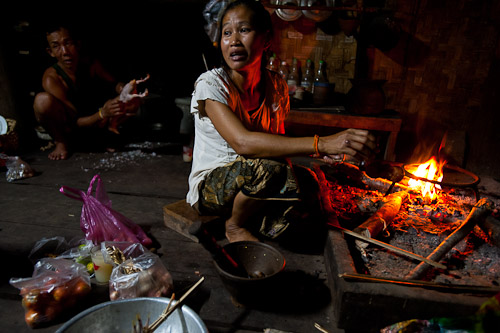 More and more communities in rural Laos are opening up their doors to foreign visitors in the form of homestays. Ban Hat Khai, a village located at the edge of Phu Khao Khuai National Protected Area, in central Laos, is an example of this. I spent a night with a family there a week or so ago, and in addition to meeting some very nice people and gaining an insight into rural Lao life, I also got to witness some Lao food made firsthand. The resulting three dishes comprised one of the better meals I had in Laos.
More and more communities in rural Laos are opening up their doors to foreign visitors in the form of homestays. Ban Hat Khai, a village located at the edge of Phu Khao Khuai National Protected Area, in central Laos, is an example of this. I spent a night with a family there a week or so ago, and in addition to meeting some very nice people and gaining an insight into rural Lao life, I also got to witness some Lao food made firsthand. The resulting three dishes comprised one of the better meals I had in Laos.
The first recipe I witnessed is essentially a 'dip' of grilled tomatoes that is as simple as it is delicious, and is also very Lao. The second two dishes took full advantage of two live ducks picked up at the market. On previous visits to Laos I hadn't really noticed how fond the Lao are of duck, but on this trip I seemed to see it everywhere, particularly grilled, which other than Bali, where I think it's technically roasted, is something haven't really encountered elsewhere in Southeast Asia.
Jaew Mak Len
Tomatoes, 4
Medium-sized chilies, 5
Shallots, 5
Garlic, 2 small heads
Salt, to taste
Fish sauce, to taste
Cilantro, green onion, chopped
Skewer the tomatoes and grill over a coals until the exterior is slightly charred and the inside is tender. Toss the chilies, shallots and garlic directly into the coals. When slightly burnt on the outside and soft inside, remove from coals, and along with the tomato, peel off all the burnt bits. In a mortar and pestle, pound grilled ingredients together into a rough paste/dip and season to taste with salt and fish sauce (and MSG, if desired). Garnish with chopped cilantro and green onion and serve with sticky rice and par-boiled vegetables such as green beans or cabbage.
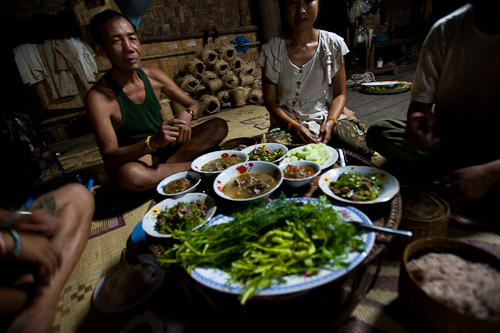
Tom Pet and Laap Pet
Ducks, 2
Ginger, peeled and sliced, one 5cm section
Galingale, peeled and sliced, one 5cm section
Shallots, peeled, 6
Chillies, red, 3
Lemongrass, bruised, 2 stalks
MSG, to taste
Fish sauce, to taste
Small sour tomatoes, halved, 10
Young tamarind leaves
Cilantro, one small bunch, chopped
Phak hom laap (a local herb; substitute with mint), equal to amount of cilantro, chopped
Green onions, 4 stalks, chopped
Shallots, 4, sliced
Khao khua (ground roast sticky rice), about 2 Tbsp
Fish sauce, to taste
MSG, to taste
Lime juice, to taste
Kill ducks. Remove innards and feathers. Joint ducks, separating the bones from the meat. Skewer the meat bits and grill over coals until fully cooked.
For the tom pet, a duck broth, while meat is grilling, bring a large pot of water, enough to accommodate the bones from both ducks, to a boil. Add ginger, galingale, shallots, chilies and lemongrass. Bring to the boil and allow to simmer for about 20 minutes. Season to taste with MSG and fish sauce, add tomatoes and young tamarind leaves. The resulting broth should be equal parts meaty and tart.
For the laap, when the meat is grilled, chop finely and mix with the chopped herbs. Add sliced shallots, khao khua, fish sauce, MSG and lime juice to taste. Serve with a platter of additional fresh herbs (more cilantro, a few sprigs of dill, mint) and sticky rice.
If you're interested in taking part in a homestay in Ban Hat Khai, information on visiting Phu Khao Khuai is available at the Tourist Information Centre in Vientiane.
 Khao soi, a northern-style curry noodle dish, is quite possibly the Thai dish that I get the most inquiries about. Foreigners in particular seem to love it, and understandably; with khao soi you've got meaty, rich, oily spicy, crunchy, soft, salty and sour all in one bowl. Unfortunately, given its northern origins, khao soi is relatively hard to come by in Bangkok, and I suspect that Pantip, the IT mall in central Bangkok, was for a long time one of the handful of places here where the dish was available. People had been mentioning this vendor's khao soi to me for years, but I'd never investigated until today.
Khao soi, a northern-style curry noodle dish, is quite possibly the Thai dish that I get the most inquiries about. Foreigners in particular seem to love it, and understandably; with khao soi you've got meaty, rich, oily spicy, crunchy, soft, salty and sour all in one bowl. Unfortunately, given its northern origins, khao soi is relatively hard to come by in Bangkok, and I suspect that Pantip, the IT mall in central Bangkok, was for a long time one of the handful of places here where the dish was available. People had been mentioning this vendor's khao soi to me for years, but I'd never investigated until today.











 First of all, allow me to apologise for not having blogged for such a long time. I had back surgery in early July and since then have been recovering, admittedly with enough time to blog, but unfortunately little in the way of content or desire. I’m more or less mobile now and am ready to jump...er carefully lower myself back into blogging again.
First of all, allow me to apologise for not having blogged for such a long time. I had back surgery in early July and since then have been recovering, admittedly with enough time to blog, but unfortunately little in the way of content or desire. I’m more or less mobile now and am ready to jump...er carefully lower myself back into blogging again.



 Sawang is a decades-old bamee (wheat and egg noodles) joint virtually across the street from Bangkok's Hualamphong Train Station. It's easily located by its overabundance of florescent green lighting and the aged and rather grumpy owner who sits in a chair out front. Some aged promotional material inside desribes Sawang as "The most expensive bamee in Thailand." Yet despite these ominous attributes, it's now my favourite place in town to eat the dish.
Sawang is a decades-old bamee (wheat and egg noodles) joint virtually across the street from Bangkok's Hualamphong Train Station. It's easily located by its overabundance of florescent green lighting and the aged and rather grumpy owner who sits in a chair out front. Some aged promotional material inside desribes Sawang as "The most expensive bamee in Thailand." Yet despite these ominous attributes, it's now my favourite place in town to eat the dish.


 Jay So originally comes from Yasothon, if I remember correctly, and opened her eponymous northeastern Thai restaurant in Bangkok's Silom area more than a decade ago. She's cheeky and boisterous, and eating at her place, with the smell of plaa raa (fermented fish) and the sound of the northeastern Thai dialect being spoken, is probably not unlike eating at restaurant in her home province. I've been eating here for years, and despite not having been back in a long while, she still somehow remembered that I like my som tam without sugar.
Jay So originally comes from Yasothon, if I remember correctly, and opened her eponymous northeastern Thai restaurant in Bangkok's Silom area more than a decade ago. She's cheeky and boisterous, and eating at her place, with the smell of plaa raa (fermented fish) and the sound of the northeastern Thai dialect being spoken, is probably not unlike eating at restaurant in her home province. I've been eating here for years, and despite not having been back in a long while, she still somehow remembered that I like my som tam without sugar.




 Despite having many of the same culinary resources and origins as neighbouring Thailand, the people of Laos subside on a markedly more basic diet. Considering Laos's poverty and lack of both infrastructure and large-scale agriculture, this shouldn't come as much of a surprise. But the monotony of the rural Lao diet can come as a shock if you've never encountered it personally.
Despite having many of the same culinary resources and origins as neighbouring Thailand, the people of Laos subside on a markedly more basic diet. Considering Laos's poverty and lack of both infrastructure and large-scale agriculture, this shouldn't come as much of a surprise. But the monotony of the rural Lao diet can come as a shock if you've never encountered it personally. 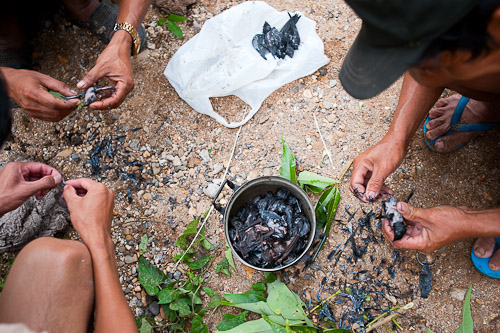
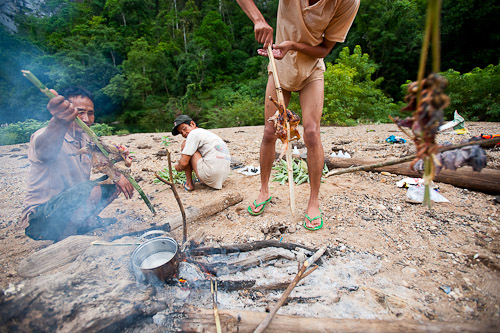
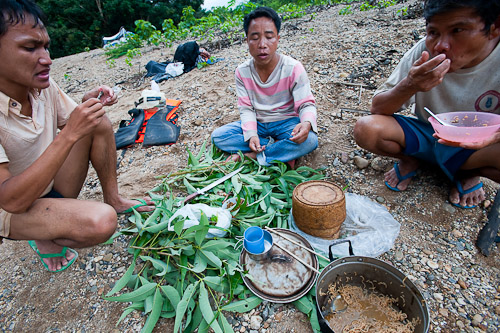

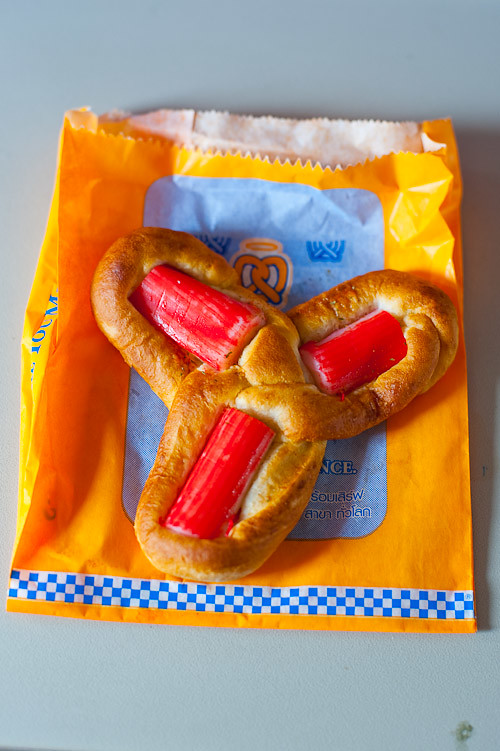 A three-pronged Auntie Anne's pretzel topped with hearty sticks of imitation crab. Encountered on a Nok Air flight from Bangkok to Nakhon Phanom. Resemblance to airplane propeller moderate, but edibility negligible.
A three-pronged Auntie Anne's pretzel topped with hearty sticks of imitation crab. Encountered on a Nok Air flight from Bangkok to Nakhon Phanom. Resemblance to airplane propeller moderate, but edibility negligible. Tanks crossing the barricade into the protesters' camp, Bangkok
Tanks crossing the barricade into the protesters' camp, Bangkok As mentioned
As mentioned 

 Damage and burning along Rama IV, Bangkok
Damage and burning along Rama IV, Bangkok I live just off of Thanon Silom, which in addition to being the area of Bangkok with arguably the most restaurants and street food, is also directly adjacent to the epicentre of
I live just off of Thanon Silom, which in addition to being the area of Bangkok with arguably the most restaurants and street food, is also directly adjacent to the epicentre of 

 Government soldier looks for snipers on Thanon Rama IV, Bangkok
Government soldier looks for snipers on Thanon Rama IV, Bangkok  Anti-government 'red shirt' protesters taunt soldiers, Rama IV, Bangkok
Anti-government 'red shirt' protesters taunt soldiers, Rama IV, Bangkok Locals cautiously watching the conflict unfolding on Rama IV, Bangkok
Locals cautiously watching the conflict unfolding on Rama IV, Bangkok Red shirt protesters stand their ground on Rama IV, Bangkok
Red shirt protesters stand their ground on Rama IV, Bangkok Red shirt protesters taunt soldiers, Rama IV, Bangkok
Red shirt protesters taunt soldiers, Rama IV, Bangkok Soldiers prepare to fire on red shirt protesters, Rama IV, Bangkok
Soldiers prepare to fire on red shirt protesters, Rama IV, Bangkok Red shirt protesters taunt soldiers on Thanon Rama IV
Red shirt protesters taunt soldiers on Thanon Rama IV  A violent confrontation between red shirt protesters and government soldiers along Rama IV
A violent confrontation between red shirt protesters and government soldiers along Rama IV  Soldiers preparing to fire at red shirt protesters on Thanon Rama IV
Soldiers preparing to fire at red shirt protesters on Thanon Rama IV  Soldiers firing an alleged mixture of rubber bullets, blanks and real bullets at protesters, Thanon Rama IV
Soldiers firing an alleged mixture of rubber bullets, blanks and real bullets at protesters, Thanon Rama IV  Captured red shirt protesters near Lumphini Boxing Statdium, Bangkok
Captured red shirt protesters near Lumphini Boxing Statdium, Bangkok Soldiers unrolling barbed wire along Rama IV, Bangkok. Smoking tires can be seen in the background.
Soldiers unrolling barbed wire along Rama IV, Bangkok. Smoking tires can be seen in the background.
 Locals look at burning tires on a bridge near Thanon Silom
Locals look at burning tires on a bridge near Thanon Silom 










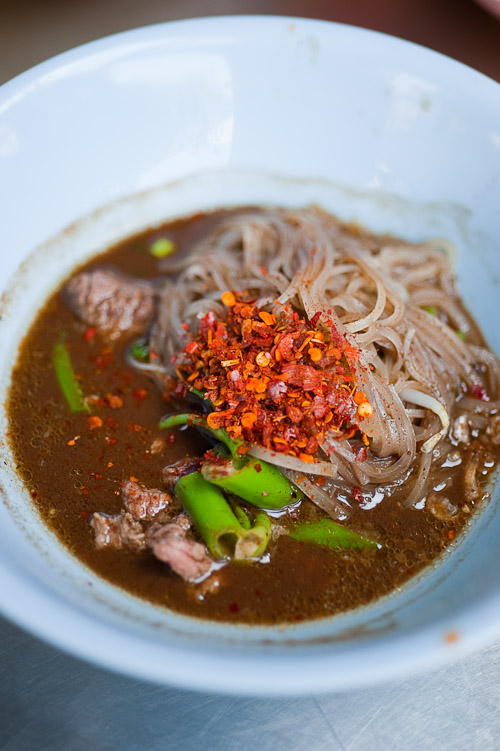 Urai, a boat noodle restaurant in Ayuthaya's Sena District, is part of a government-funded scheme called Thong Fah ('Blue Flag') that has established exceedingly cheap restaurants, often serving regional dishes, around the country (
Urai, a boat noodle restaurant in Ayuthaya's Sena District, is part of a government-funded scheme called Thong Fah ('Blue Flag') that has established exceedingly cheap restaurants, often serving regional dishes, around the country (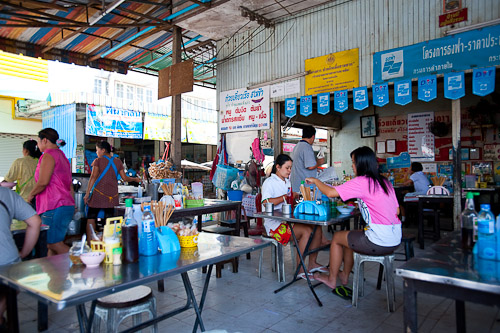
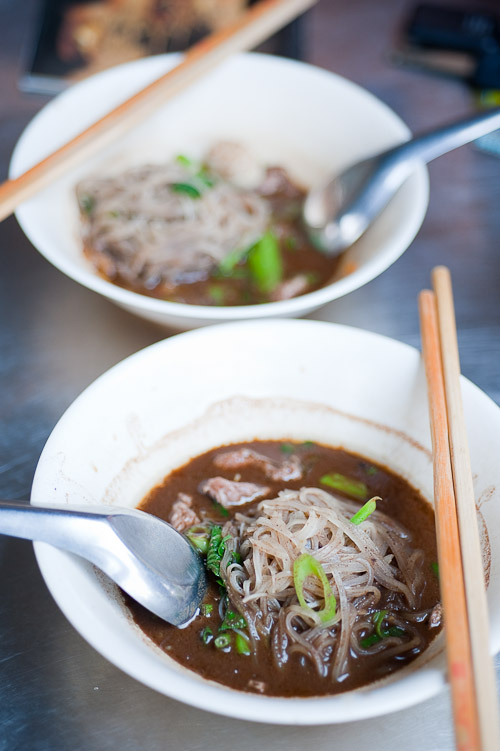
 I'm finally back home after about two months in Laos, and yet again, am craving odd Thai dishes. This time it's kuaytiaw reua (boat noodles), so naturally I headed to the heartland of the dish (and possibly one of the more underrated food cities in Thailand), Ayuthaya.
I'm finally back home after about two months in Laos, and yet again, am craving odd Thai dishes. This time it's kuaytiaw reua (boat noodles), so naturally I headed to the heartland of the dish (and possibly one of the more underrated food cities in Thailand), Ayuthaya.
 It wasn't all sticky rice and grilled meat for the last couple months. Setting out on a road trip to central Laos with my trusty driver Christophe (above, on the left), I picked up a grab bag of French goodies at Les Boutiques Scoubidou, Vientiane's best French deli:
It wasn't all sticky rice and grilled meat for the last couple months. Setting out on a road trip to central Laos with my trusty driver Christophe (above, on the left), I picked up a grab bag of French goodies at Les Boutiques Scoubidou, Vientiane's best French deli:

 More and more communities in rural Laos are opening up their doors to foreign visitors in the form of homestays. Ban Hat Khai, a village located at the edge of
More and more communities in rural Laos are opening up their doors to foreign visitors in the form of homestays. Ban Hat Khai, a village located at the edge of 
 Boat driver on the Nam Kading River, Laos
Boat driver on the Nam Kading River, Laos If you spend enough time on Rte 8, the Lao highway corridor linking Thailand and Vietnam, you’re bound to encounter huge lorries bound for Vietnam carrying cages filled with hundreds of dogs.
If you spend enough time on Rte 8, the Lao highway corridor linking Thailand and Vietnam, you’re bound to encounter huge lorries bound for Vietnam carrying cages filled with hundreds of dogs.